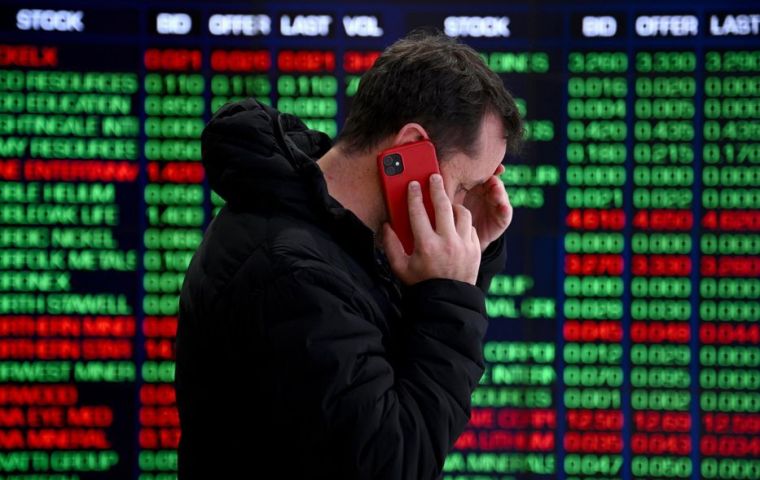MercoPress. South Atlantic News Agency
Markets slump worldwide amid Trump’s tariff war and recession fears
 Donald Trump's tariffs set stock markets worldwide on a slide
Donald Trump's tariffs set stock markets worldwide on a slide US stocks experienced significant volatility Monday amid a global trade war sparked by President Donald Trump’s tariffs. In addition, Washington threatened China to impose an additional 50% surcharge if Beijing does not retract its own 34% increase by Tuesday.
In this scenario, the Dow Jones dropped as much as 1,200 points (3%), the S&P 500 fell up to 4.7%, and the Nasdaq declined 3%, with both the S&P and Nasdaq entering or nearing bear market territory. Stocks later recovered somewhat, with the Dow closing down 349 points, the S&P slightly negative, and the Nasdaq flat to slightly up. The tariffs, effective from Saturday, escalated trade war fears after failed weekend negotiations and China’s retaliation. Trump doubled down on his stance via Truth Social, prompting concern from business leaders.
Germany’s DAX fell over 4%. Other European markets also suffered, with Milan and Madrid down 5.1%, Paris and Amsterdam falling 4.7%, London declining 4.4%, and Frankfurt losing 4%. Over three days, European stock markets lost € 1.924 trillion, including € 683 billion on the latest day. The EU is preparing countermeasures to Trump’s tariffs, set for April 15 if talks fail, while UK Prime Minister Keir Starmer called for calm and emphasized maintaining US-UK ties. The UK's FTSE 100 hit a one-year low. At the same time, the Italian BTP-German Bund spread stayed stable at 125 basis points, though European bond yields, especially UK bonds, rose sharply (UK 10-year at 3.86%). The euro held at 1.09 against the dollar, while Bitcoin fell 5% below US$ 80,000.
JP Morgan raised the likelihood of a global recession to 60% while commodities like US crude oil and Bitcoin saw sharp declines. A debunked rumor of a 90-day tariff pause briefly stirred markets. Experts criticized the tariffs, noting widespread margin calls and Wall Street’s disapproval.
Major bank leaders from Bank of America, Barclays, Citi, and HSBC reportedly held a call to assess the crisis, reflecting widespread concern. Goldman Sachs predicted China would accelerate fiscal stimulus to counter a projected 0.7% GDP hit in 2025 due to the tariffs, despite previously strong growth.
Energy markets were volatile, with oil dropping below US$ 60 per barrel in New York—its lowest in four years—before stabilizing, and gas in Amsterdam slightly up at € 37 per megawatt hour after a mostly negative day.
Wall Street marked its third consecutive day of declines amid the ongoing panic.
Monday dawned with Australia's and most Asian stock markets experiencing significant declines. Hong Kong’s Hang Seng Index opened by dropping 9.1%, with a peak intraday fall of 10.2%, marking its worst day in over a year. Across the Asia-Pacific, 11 of 14 equity markets hit 52-week lows. In mainland China, the CSI 300 Index fell by 7.6%, while the Shanghai and Shenzhen Composite Indexes dropped by 7.4% and 9.8%, respectively. Japan’s Topix and Nikkei indexes also slumped, by 9.6% and 6.5%, respectively.
South Korea’s KOSPI sank over 4%, with the won nearing a 16-year low against the dollar. The Bank of Korea warned of prolonged market volatility due to Trump’s tariffs, including a 25% duty on South Korean goods effective Wednesday and a 10% baseline tariff on all imports from Saturday, urging swift market stabilization measures.
Taiwan’s TAIEX fell below 20,000 points, losing over 2,000 points, with major stocks like Taiwan Semiconductor, Hon Hai, and MediaTek hitting daily loss limits alongside heavy losses in AI shares on the first trading day after the Qingming Festival.
And while Australia’s ASX 200 dropped more than 6%, European brewers fear significant losses in the new scenario as Wall Street braces for further recession and escalating trade tensions. Holders are rapidly selling off their stock.




Top Comments
Disclaimer & comment rulesCommenting for this story is now closed.
If you have a Facebook account, become a fan and comment on our Facebook Page!